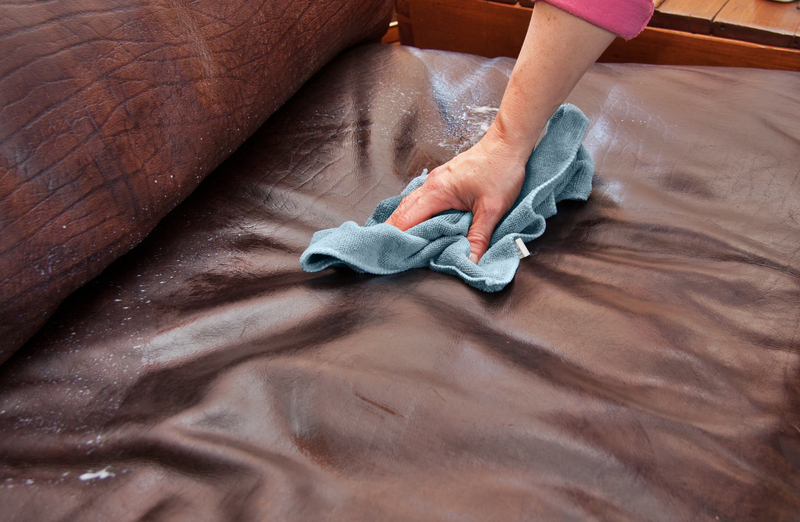Jewelry Cleaning: From Tarnish to Tranquil
Posted on 04/06/2025
Jewelry Cleaning: From Tarnish to Tranquil
Jewelry is more than an accessory; it is a statement, a precious memory, and sometimes, a family heirloom. Over time, even the most cherished pieces can lose their sparkle due to exposure to air, dust, lotions, and oils. Luckily, cleaning your jewelry is not only possible but also simple and satisfying. In this comprehensive guide on Jewelry Cleaning: From Tarnish to Tranquil, we'll explore why jewelry tarnishes, the best methods to restore its brilliance, and tips to maintain its shine, ensuring your pieces remain forever dazzling.

Understanding Why Jewelry Tarnishes
Before diving into jewelry cleaning techniques, it's essential to understand why your precious metals and stones lose their luster.
- Oxidation: Silver and some types of gold react with air, causing a layer of tarnish that dulls their natural brightness.
- Exposure to Substances: Everyday items like lotions, perfumes, sweat, and household cleaners can accelerate tarnishing and dullness.
- Buildup of Debris: Dirt, dust, dead skin, and oils accumulate, particularly in the crevices of rings, necklaces, and bracelets.
- Improper Storage: Storing jewelry in humid locations or together with other pieces can lead to scratches and tarnish.
Knowing the culprits behind the fading of your jewelry helps you better care for and restore each piece back to its original splendor.
The Importance of Regular Jewelry Cleaning
Why should you clean your jewelry regularly?
- Longevity: Regular cleaning prevents buildup and slows down tarnishing, enhancing the lifespan of your jewelry.
- Appearance: Clean jewelry shines brighter and appears more attractive.
- Hygiene: Jewelry can collect bacteria and germs. Cleaning it reduces risks of skin irritations and infections.
- Maintenance: Frequent checking during cleaning helps spot loose stones or broken clasps early.
Types of Jewelry and Their Cleaning Needs
Not all jewelry is created equal, and neither are their cleaning needs. Below, we break down common types of jewelry and how their materials affect their care.
1. Gold Jewelry Cleaning
- Pure Gold: Soft and easy to scratch. Needs gentle cleaning.
- Gold Alloys: Mixed with metals that can tarnish. Requires more frequent cleaning.
Use mild soap and water for routine cleaning. Avoid harsh chemicals.
2. Silver Jewelry Cleaning
- Sterling Silver: Prone to tarnish. Requires special silver polish or gentle homemade solutions.
Polishing cloths and professional silver dips are effective for stubborn tarnish.
3. Platinum Jewelry Cleaning
- Very resilient, but still accumulates dirt and scratches with wear.
Use a soft brush and soapy water for cleaning, then buff with a designated cloth.
4. Gemstone and Diamond Cleaning
- Hard Stones (Diamonds, Sapphires): Can handle most cleaning methods.
- Soft Stones (Pearls, Opals): Require delicate care, avoiding harsh chemicals and abrasives.
5. Costume Jewelry Cleaning
- Made of less precious metals and glued stones. Water and chemicals can cause damage.
Wipe with a soft, slightly damp cloth instead of soaking or vigorous scrubbing.
DIY Jewelry Cleaning Methods: Step-by-Step Guide
Ready to restore your jewelry from tarnished to tranquil? Here are time-tested jewelry cleaning recipes and methods you can easily try at home.
1. Mild Soap and Water
- Good for: Gold, platinum, diamonds, and most gemstones.
Steps:
- Mix a few drops of mild dish soap in a bowl of lukewarm water.
- Let the jewelry soak for 10-15 minutes.
- Use a soft toothbrush to gently remove dirt, especially in crevices.
- Rinse under clean water and dry with a soft microfiber cloth.
2. Baking Soda Paste for Silver Jewelry
- Perfect for tarnished sterling silver.
Steps:
- Make a thick paste using three parts baking soda to one part water.
- Rub the paste onto silver using a soft cloth or sponge.
- Gently polish and rinse under warm water.
- Buff dry for a brilliant shine.
3. Commercial Jewelry Cleaners
- Effective for most fine jewelry and quick touch-ups.
Tips:
- Always follow the product's instructions.
- Do not use these on pearls, opals, or other delicate, porous stones.
4. Aluminum Foil and Baking Soda Method
- Removes tarnish from silver jewelry with chemical reaction.
Instructions:
- Line a bowl with aluminum foil, shiny side up.
- Place silver pieces on the foil.
- Sprinkle generous baking soda and a pinch of salt over the jewelry.
- Pour hot (not boiling) water to cover the items.
- Let sit for a few minutes – tarnish will transfer to the foil.
- Rinse and dry thoroughly.
5. Gentle Vinegar Solution
- Great for removing grime from solid pieces (avoid on glued jewelry).
Recipe:
- Soak the jewelry in a mixture of half white vinegar and half water for a few minutes.
- Brush gently, rinse, and dry.
6. Cleaning Pearls and Soft Gems
- Never soak. Use a damp, soft cloth only.
Special Care: Wipe each pearl individually. Let them air dry completely before storing.
Professional Jewelry Cleaning: When to Seek Expert Help
Some environments, settings, or types of jewelry require professional attention. Here's when to visit a jeweler:
- Heavily Tarnished or Damaged Jewelry: Restore brilliance safely with professional cleaning and polishing.
- Intricate or Antique Pieces: Expert cleanings prevent damage to delicate components.
- Routine Maintenance: Quarterly or semi-annual checkups ensure settings and clasps remain secure.
Precautions: What Not to Do When Cleaning Jewelry
While home cleaning is effective, mistakes can lead to irreversible damage. Always avoid the following:
- Bleach and Abrasive Cleaners: Can dissolve or scratch metals and gems.
- Boiling Water: May crack stones and loosen glues.
- Ultrasonic Cleaners: Can loosen stones or damage certain gems and treated pieces.
- Paper Towels: Rough fibers may scratch precious metals or soft gems.
When in doubt, consult a jeweler before attempting to clean a valuable or delicate item at home.
How Often Should You Clean Your Jewelry?
Frequency depends on:
- How often you wear it.
- Type of jewelry and material.
- Exposure to lotions, sweat, perfumes, and dust.
As a rule of thumb:
- Everyday Jewelry: Clean monthly and wipe with a cloth weekly.
- Special Occasion Pieces: Clean before and after use, and before long-term storage.
- Silver Jewelry: Polish every few months or at the first sign of tarnish.
Tips for Maintaining Sparkling Jewelry and Preventing Tarnish
Jewelry cleaning is only half the story. Preventing tarnish and dullness keeps your collection tranquil and timeless. Here's how:
- Store in a Dry, Cool Place: Use anti-tarnish bags or cloths. Keep items separate to avoid scratches.
- Avoid Moisture: Remove jewelry before bathing, swimming, or exercising.
- Minimize Exposure to Chemicals: Apply perfumes, lotions, and cosmetics before putting on your jewelry.
- Regular Inspections: Check for loose stones, bent prongs, or damaged clasps each time you clean.
- Professional Cleaning: Schedule regular expert check-ups for your most valuable or sentimental pieces.
Answers to Frequently Asked Jewelry Cleaning Questions
Can you clean jewelry with toothpaste?
Toothpaste is abrasive and can scratch metals and stones--it's best to avoid using it for jewelry cleaning.
What is the safest homemade jewelry cleaner?
A mix of mild dish soap and water is safe for most jewelry cleaning. Baking soda paste and vinegar solutions are also gentle if used correctly.
How do you clean tarnished silver quickly?
The aluminum foil and baking soda method mentioned above is the fastest way to remove heavy tarnish from silver.
Is jewelry cleaning necessary for all types of gems?
Yes, but the method varies. Hard stones tolerate more robust cleaning, while pearls, opals, and other soft gems need gentle care.
How can I keep my jewelry from tarnishing?
Store it properly, keep it dry, and clean it regularly. For silver, anti-tarnish strips in your jewelry box work wonders.
Eco-Friendly and Non-Toxic Jewelry Cleaning Options
As we become more conscious of our environmental impact, using eco-friendly jewelry cleaning techniques has grown in popularity. Here's how to achieve tranquil shine without harsh chemicals:
- Baking Soda: Non-toxic and effective for most metals.
- White Vinegar: Disinfects and removes grime when used moderately.
- Lemon Juice: Works on brass or copper, but not for precious stones and silver.
- Cornstarch Paste: Gently removes tarnish and restores shine.
- Filtered Water: Soft water prevents mineral deposits on your jewelry.

When to Let Jewelry Rest: Storing for Tranquility
Sometimes, the best way to preserve your jewelry's beauty is--not to wear it at all. Long-term storage must be done with care, ensuring tranquility and protection from tarnish.
- Clean jewelry before storing.
- Keep each piece in a separate soft pouch or lined box.
- Add silica gel packets to absorb moisture and prevent corrosion.
- Document and photograph valuable pieces for insurance and safekeeping.
Conclusion: Transforming Tarnish to Tranquil
With simple jewelry cleaning routines and informed care, your favorite pieces can move from faded and tarnished to tranquil and radiant. Whether it's a daily-wear ring or a special-occasion pendant, proper cleaning methods keep jewelry sparkling for years and generations to come. Enjoy the process--it's more than maintenance; it's a celebration of your treasures.
Remember: Consistency in cleaning and storage is the secret to maintaining tranquil beauty. Treat your jewelry with the love it deserves, and it will shine for a lifetime and beyond.




